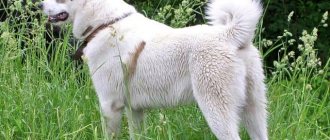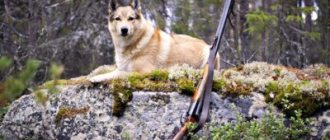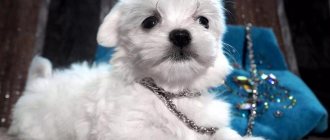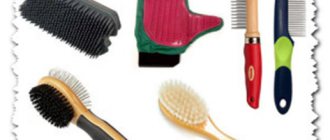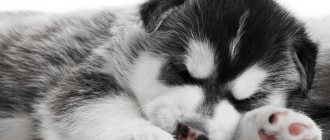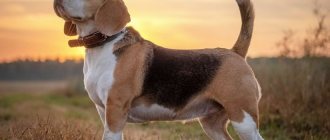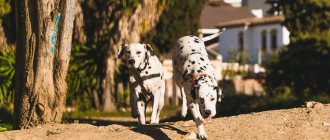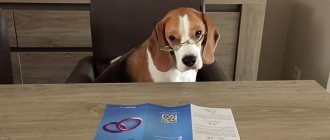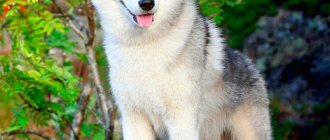| Intelligence: |
| Aggressiveness: |
| For security: |
| For children: |
| Training: |
| Difficulty in care: |
The Norwegian Lundehund or Norwegian Laika is a very ancient breed of dog, bred in Norway, which was previously widespread in the Scandinavian countries and on the northern coast of the Atlantic Ocean. Initially, these dogs were used to hunt puffins - waterfowl that make their nests in inaccessible coastal rocks. The breed took its name from these birds, from the Norwegian lunde - dead end, hund - dog.
The Norwegian Lundehund was an excellent hunter. These dogs have six toes on their paws, which allows them to move deftly along rocky shores. Huskies also have a body flexibility that is rare for dogs, thanks to which they can easily move through narrow caves and gorges in search of birds. While swimming, the dog presses its ears tightly to its head, preventing water from penetrating inside, and the thick undercoat prevents the husky from becoming overcooled in cold water.
In the mid-19th century, due to the cessation of hunting puffins with dogs, the Norwegian Lundehund breed was very close to complete extinction. But by the middle of the 20th century, several representatives of this breed were discovered in Norway, and the breed was saved through the efforts of dog handlers and breeders. Nowadays, Norwegian Huskies are found mainly in Scandinavian countries and are used as domestic companion dogs.
Maintenance and care
Despite their compact size, dogs of this breed are not suitable for living in an apartment, since they need a lot of space to move freely. It is better to keep Norwegian Laikas in a private house with a large yard, where there is room for long and productive walks.
Representatives of the breed do not require special care, you just need to carry out the following hygiene procedures:
- comb the coat once a week;
- bathe your pet once every three months with a special shampoo;
- trim claws once a month;
- regularly clean your ears and teeth, wipe your eyes;
- Once every six months, treat your pet for worms, fleas and ticks.
Notes
- ↑
- ↑ Krukover V.I.
Dogs. The most complete encyclopedia. - M.: Eksmo, 2013. - P. 129. - 464 p. — ISBN 978-5-699-59539-6. - ↑
- ↑
- ↑
- ↑ Dogs. Breeds, care, breeding. Mini-atlas / Vol. ed. O. V. Zhakova. - St. Petersburg: Publishing House "Crystal", 2002. - P. 54. - 96 p. — 10,000 copies. — ISBN 5-306-00242-0.
- Pocket Genius: Dogs. Facts at your fingertips / N. Gupta, C. Stamps. — New York: DK Publishing, 2016. — P. 58. — 160 p. — ISBN 978-1-4654-4585-8.
- Margaret H. Bonham.
Northern Breeds. — Barron's Educational Series, 2001. — P. 22. — 64 p. — ISBN 0-7641-1733-5. - Gough A., Thomas A.
Breed Predispositions to Disease in Dogs and Cats. - Wiley-Blackwell, 2010. - P. 516-519. — ISBN 978-1-4051-8078-8. - Padgett J.
Control of Canine Genetic Disease / Transl. Kuznetsova O.V. - M.: “Sofion”, 2006. - P. 212. - 280 p. — (Veterinary Sciences). — ISBN 5-9668-0013-8. - Mullen P., Pohland G.
Find Your Perfect Dog Breed! How to Choose the Right Dog. - 2015. - P. 236. - ISBN 978-3-946074-08-3.
Buhund care
Norwegian Shepherds are unpretentious dogs; for them, conscientious fulfillment of basic care responsibilities by the owner is sufficient.
Conditions of detention
Due to their medium size, Norwegian Buhunds can be comfortably kept both in apartments and in private homes. Due to the characteristics of the coat and the place of origin of the breed, representatives are often kept not indoors, but in outdoor enclosures, where they feel great. However, in order for the dog not to lose its energy, time with it must be spent actively. Walks (regardless of the type of content) should be daily, at least 1–2 hours with active games and moderate physical activity. Lack of sufficient activity will cause destructive behavior and animal protest.
General care
There are no special features in keeping buhunds; the owner only needs to carry out all the standard procedures:
- comb the coat 1-2 times a week and daily during shedding;
- bathe as needed;
- clean your ears when they become dirty (inspection for such a need should be done once a week);
- brush your teeth;
- Trim nails as they grow.
When properly cared for, Norwegian Shepherds do not have an unpleasant dog odor.
Nutrition
Feeding Norwegian Shepherds requires following basic rules of a healthy diet. On a natural diet, a dog should receive:
- fresh meat (beef, chicken, rabbit, turkey);
- low-fat fermented milk products, in particular cottage cheese;
- valuable by-products (heart, liver);
- plant products (unsweetened fruits, vegetables, herbs);
- cereals (only rice, buckwheat and oatmeal are allowed).
It is better to completely avoid bread and other baked goods, sweets, and seasonings in your dog’s diet.
If we talk about industrial diets, then only super-premium and holistic class products will be truly high-quality. For Buhunds, the best choice is food for medium-sized dogs with increased activity (Royal Canin Medium Adult, Hills Adult Medium, Brit Care Adult Endurance Duck & Rice for adult active dogs, etc.).
For Buhunds, food for medium-sized breeds is suitable, for example Royal Canin Medium Adult
Training
By nature, Buhunds are endowed with curiosity and a lively mind; they easily learn new knowledge and commands. Therefore, you can teach your dog the basics of behavior and obedience even without professional help. Socialization is also necessary - this will allow the dog to adequately relate to other animals and people, without going too far with suspicion. One of the main problems that will have to be dealt with during training is the excessive barking that is characteristic of the breed.
Feeding
To maintain the active functioning of the Lundehund, it is necessary to feed it a balanced diet, the main share of which should consist of lean meat. You can give beef and horse meat, cut into medium pieces. You can also add offal and sea fish to your diet.
Porridges made from rice, oatmeal or buckwheat will add essential carbohydrates to your diet. And cottage cheese and kefir will compensate for the lack of calcium. Vitamins are found in large quantities in vegetables and fruits. They can be grated and added to meat or cereals.
Standard
The Norwegian Lundehund belongs to the group of Spitz-shaped dogs. Existing standards describe the appearance of these dogs as follows:
- The maximum height at the withers reaches thirty-eight centimeters.
- The average weight is six kilograms.
- The body is very mobile and flexible.
- The movable neck allows the dog to turn around so that the tip of the nose touches the back.
- The head is slightly elongated, the nasal septum has a small hump.
- The eyes are oval in shape, the iris is golden in color.
- The tip of the nose is pigmented black.
- Ears in the form of small triangles on large cartilage. They have the ability to move in such a way as to close the ear canal at the right time.
- The limbs are equipped with incredibly flexible joints.
- Paws are unique to dogs and can be called cat-like.
- The tail is either in a lowered state or curled on the back in the form of a ball.
- The coat is thick and tough. On the muzzle and paws it is shorter than on other parts of the body. The longest on the neck and tail.
- There is a thick, reliable undercoat.
Interesting Facts
Quite little is known about Norwegian moose huskies, but several interesting facts are still associated with them:
- The elk husky belongs to the group of primitive breeds, but this characteristic does not apply to intellectual abilities. This is the name given to animals that have formed naturally with minimal human intervention.
- The remains of a dog resembling a modern moose husky were discovered in the Norwegian Vist Cave. The find dates back to the Bronze Age, that is, it is about 5-6 thousand years old.
- Norwegian Elkhunds were faithful companions of the Vikings. Skeletons of dogs are often found near the graves of their owners.
Norwegian Lundehund: photo, description of the breed
1402
Article rating
The Norwegian Lundehund, also known as the Norwegian Puffin Husky, is the oldest breed of dog from Norway. Today there are only a few of them preserved on the northwestern Norwegian coast, which became the founders for the preservation and reproduction of the breed.
Norwegian Lundehund
The uniqueness of Norwegian dogs
Norwegian Lundehund dogs appeared in the 16th century from dwarf representatives of elk breeds with the purpose of helping in hunting mountain partridges. During the night alone, skilled lundehunds caught up to 80 birds and, with due care, carried partridge eggs in their teeth, which were valued by local residents. Lunde is the name of those birds in Norwegian, from which the name of the breed comes.
The Norwegian Lundehund is unique not only as a hunter. It differs from other representatives in appearance and acrobatic capabilities. These dogs are very flexible, capable of touching their back with their nose and throwing their head back. Naturally able to navigate narrow paths and mountain crevices, the Lundehund tends to spread its front paws wide to the sides, just as a person spreads his arms. The Norwegian hunter knows how to fold his always erect ears so that the ear canals are closed, preventing the penetration of foreign objects, dust and water. In addition, Lundehunds have extra toes on all four paws to help them climb rocks.
Lundehund Appearance Standard
Males of the Norwegian Lundehund reach a height of up to 35-38 cm and weigh up to 7 kg, females are slightly lower and a little lighter, from 32 to 35 cm and up to 6 kg.
General physique
The photo of the dog shows that its body is slightly stretched, but built firmly. The oval-shaped paws are slightly turned outward. One of the distinguishing features of the breed is six-toed dogs. The back is straight in line with a sloping croup. The chest is located quite deep in front between the paws. The tail is of medium length, covered with thick hair and set high, wrapped in a ring shape, extending to the line of the back, and can hang freely.
Head
It has triangle proportions and medium-sized width, the transition from the frontal bone to the muzzle is quite clearly visible, the forehead is slightly convex. The parietal part is longer than the muzzle, which is quite noticeable. The color of the iris is dark brown or yellow brown. The eyes are slightly slanted. The ears are triangular in shape, wide at the base and medium in size. Located in a standing position, movable.
Color
The coat is thick and dense, only on the head and paws it is short and smooth. There is a soft undercoat.
The breed standard allows red-brown and yellow-brown shades of coat, but the presence of white is a prerequisite. You can often find black tips. The color can also be gray or white, diluted with dark spots.
The character of the Norwegians
Norwegian hunters are absolutely non-aggressive dogs, calm and cheerful in nature. They can be affectionate family pets, but are strong and energetic when necessary, and can also be independent. Therefore, when keeping a dog at home, breeders recommend starting the training process as early as possible.
When adopted by a family, Lundehunds quickly get used to the residents and love children endlessly. In addition, they are quite calm towards other representatives of the canine world, do not show increased attention and do not use force.
The Norwegian Lundehund is suspicious and wary of strangers.
Purebred dog - Norwegian Huskies or Lundehunds
Norwegian Lundehund
5 RARE DOG BREEDS
Active by temperament, such dogs are ready to spend hours in the fresh air, running, playing and chasing birds. When the dog is given sufficient exercise when walking, you can be more likely to be confident in its calm behavior at home. But even in this case, the animals will not at all mind bringing various objects to the owner in the hope of playing.
Norwegian representatives require a lot of space to keep them, so keeping them indoors is not recommended. In addition, the active nature of the dog requires significant physical activity for it. They will be very happy to engage in dog sports such as agility.
Character
The Norwegian Lundehund is a hunting dog breed originally from Norway. The main specialization of these dexterous animals was catching puffins - small birds that live in rocks (their fluff and meat were highly valued in the northern regions of the country). Hence the name. Lundehund (Norwegian lundehund) consists of two words: lunde - “dead end” and hund - “dog”.
The Norwegian Lundehund is considered an ancient breed, although experts have not been able to establish its true age. Some descriptions of dogs used for bird hunting date back to the 17th century.
At the end of the 19th century, puffins began to be caught using nets, and the population of the northern islands also decreased. These factors negatively affected the development of the Norwegian Lundehund - the breed was on the verge of extinction.
The only place where purebred individuals were preserved was the small commune of Vörey. Breeders are working hard to restore the breed, which is recognized as Norwegian heritage.
Today, hunting puffins with dogs is officially prohibited in Norway. Therefore, the Lundehund is kept only as a companion. It is perfect for active people who prefer walks in the fresh air to indoor gatherings.
Despite their small size, representatives of the breed are incredibly energetic. They demonstrate excellent results in competitions in agility, obedience and other dog sports.
The Lundehund is an obedient student, although it requires attentiveness and perseverance from the owner. Animals quite often show independence if they are not satisfied with the training process.
The Norwegian Lundehund is loyal to children, especially if it grew up in a family with children. But this is not a nanny; he is unlikely to take care of his little master. The dog gets along best with schoolchildren who look after it, play with it and walk it.
The Lundehund's attitude towards animals in the house depends entirely on the dog's upbringing and the behavior of its neighbors. But in general, representatives of the breed are non-conflict and peaceful, you definitely can’t call them bullies.
Subscribe to our newsletter and get a free veterinary consultation
Thanks for subscribing!
Slugi
Slugi is a rare and ancient breed of greyhound originally from Africa. It is distinguished by its high growth, which can reach 72 cm. Their disposition is affectionate, but a little capricious. They obediently follow house rules and prefer to be the center of attention. These pets are active and energetic and easily get along with children.
The price of a puppy starts from $500.
Conditions and training
An active hunter, the Elkhound can hardly be called a sofa apartment dog. This dog requires regular physical activity in large quantities and long walks in the fresh air (at least 2-3 hours). The animal will feel best in a private area, where it will be possible to spend most of its time outside. But if the owner leads an active lifestyle, lives in a large apartment in the city and has the opportunity to pay maximum attention to his pet, there will be no problem.
Physical activity is of great importance for Elkhounds.
Training must necessarily include two basic courses: general obedience and socialization. In the first case, the owner will be required to be firm, not going beyond the limits - Elkhounds have a sense of self-esteem and some stubbornness, so without severity or if a person uses aggression, a positive result of training should not be expected. Socialization involves early exposure to other animals and people so that the dog does not become afraid of them in the future.
Characteristics and description
The Norwegian Elkhound, the Elk Husky, and the Viking Dog are all the same breed. This dog is universal - he is both a hunter and a guard for his owner or home.
- Country: Norway.
- Group: Spitz and primitive type breeds.
- Section: northern hunting dogs.
- First time at the exhibition: 1877.
- Life expectancy: 12-15 years.
Consider the most popular breeds of hunting dogs: Saluki, Greyhound (English Greyhound), Russian Greyhound, Russian-European Laika, American Cocker Spaniel, Parson Russell Terrier, Smooth Fox Terrier , “Norwich Terrier”, “Russian Spaniel”, “Russian Piebald Hound”, “English and American Foxhounds”.
Did you know? Zoologists conducted an experiment to find out which domestic animal is most careful when crossing the roadway. The goose was in first place, the pig was in second, the dog only got fifth position, ahead of the cat and even the chicken.
Appearance and photo
The Norwegian Husky is quite compact and has a square format. This dog's head is wide, its ears are erect and small. The chest is wide, voluminous, and the loin is strong. The tail stands high, curled over the back. Basic description of the breed:
- Height: males - 52 cm, females - 49 cm.
- Weight: 15-25 kg.
- Color: shades of gray, ends of hairs are black; the undercoat is light gray.
- Coat: dense, thick with a soft undercoat, large collar on the chest and around the neck.
Pet character
This dog comes from the north, he is used to harsh weather and hunting, but this does not stop him from being a gentle and loving friend. Although he never loses his vigilance, because such a dog is an excellent watchman. Let's talk about the advantages and disadvantages of the elk husky's character.
Pros:
- friendly, but distrustful of strangers;
- loves children;
- very loyal to his master;
- smart, quick-witted.
Minuses:
- reacts very emotionally to noise, begins to bark loudly;
- may overly demonstrate his independence;
- Without socialization he becomes aggressive.
Important! Yes, the Elkhound has an independent character. But if you work with the dog, there will be no problems with its behavior.
This dog is very attached to its owner. The main thing is to be gentle and firm with him at the same time.
Catalburun
This is a dog breed of Turkish origin, known for four centuries and considered the Turkish Pointer.
Catalburun is unusual because of its anomaly, which is considered the norm: it has a forked nose.
Dogs of the Catalburun breed are very small in number, therefore they are not officially recognized and do not have a breed standard.
The height of dogs at the withers ranges from 40 to 63 centimeters, weight reaches 25 kilograms. Life expectancy is 12-14 years.
The breed is short-haired, piebald in color. When choosing a Catalburun puppy, you need to keep in mind that he will be the only pet in the house. Catalburun will not bite, even if they try to tease him, but if his territory is encroached upon, surprises are possible.
Each unusual dog has its own history, inclinations, habits that have developed over centuries, and maybe even centuries. Once you become interested in a particular breed, you need to understand the pet’s priority character traits, its inclinations and abilities.
This will eliminate unpleasant surprises, help you find the right approach to the chosen pet, and ultimately give the joy of communication to both the owner and the animal. Buying a four-legged friend is a responsible step and will require the owner to change not only his daily routine, but also his habits.
Authors of the articles: Belanta Clinic team
Breed dossier
- Country of origin:
Denmark - Classification:
Group 5: Nordic Sled Dogs, Spitz, Primitive FCI Section: Section 1: Nordic Sled Dogs - Training:
Persistent training is required. The owner will need to constantly exercise his willpower to prove to the dog that he is in charge. - Color:
Any color is possible, except albino. - Dimensions.
Height at withers up to 64 cm. Weight not less than 30 kg. - General impression:
Greenland is a strong and robust dog. - Usage.
Hunting dog (seal and bear), sled dog, guard dog, companion dog.The Greenland dog was born to run in a harness.
- Physical activity:
This breed of dog needs long walks with active physical activity. - Character:
She is smart, has a lively, soft, sociable character. - :
The role of a family dog is absolutely not suitable for her. - Grooming:
This dog's coat requires regular brushing with a special brush. - Liveability:
These dogs are very friendly towards humans.Tends to dominate other dogs.
- Diseases:
Usually very healthy. - Diet:
One and a half to two and a half standard rations are recommended. - Lifespan:
about 13 years old.
Requirements for an aquarium
The aquarium is selected according to the number of fish; one adult requires at least 50 liters of water space. Moreover, short-bodied fish need a more spacious aquarium than long-bodied fish.
It is better to choose a rectangular container, contrary to the general opinion that goldfish should live only in a round aquarium. It should be noted that she is uncomfortable there, since the rounded walls distort the perception of the world around her. Fish in such glass aquariums live much shorter than their relatives living in normal conditions. Necessary equipment:
- compressor;
- internal or external filter;
- heater;
- lighting device.
The optimal temperature for short-bodied ones is +21−29 degrees, for long-bodied ones - +18−25. Required parameters: hardness - 10−15, acidity - 8. Weekly water changes are required (20% of the aquarium volume).
Where to buy a Norwegian Lundehund puppy, price
You can buy purebred Norwegian Lundehund puppies from breeders, in nurseries, from fanciers, through advertisements in Avito, on OLH. How much does a Norwegian Lundehund cost? The price of a puppy in Russia varies between 20,000 – 30,000 rubles, in Ukraine 10,000 – 15,000 hryvnia. But the cost, of course, depends on the pedigree, boy or girl, and other factors. For a purebred pet with a good pedigree, you will have to pay significantly more. There are also forums, groups on VK (VK, VKontakte), Facebook (FB), where pets are given inexpensively, free of charge, into good hands, for free (if someone agrees to accept the gift). To begin with, we recommend watching a video with this animal, a photo (there are many cool photos with a person), reading reviews from satisfied owners, articles on Wikipedia, and making a choice.
Kai
This breed was bred in Japan and is remembered for its bright brindle color. They are very dexterous and adapted to frost, which allows owners to take them hunting in the mountains.
They do not always get along with children, so it is advisable to take them into a family with older children. Such a pet will always protect its owners and will easily attack the offender.
In Russia, a dog costs approximately 40 thousand rubles.
Appearance
The Norwegian Lundhund is a small Spitz-shaped dog with a slightly elongated format. Sexual dimorphism is pronounced.
- height at the withers of males - 35-38 cm, weight - about 7 kg;
- height at the withers of females is 32-35 cm, weight is about 6 kg.
Upon closer examination, it becomes obvious that the Norwegian Lundehund has unique anatomical features:
- Thanks to its very mobile neck, the Lundehund can throw back its head so that its nose touches its back;
- All joints of the forelimbs are extremely mobile;
- The pupil of the golden eyes is surrounded by a dark rim;
- The ear cartilage is able to retract and fold, tightly closing the ear canal.
- The front feet are slightly turned outward and have at least 6 toes, 5 of which rest on the ground. The inner fingers have a common system of ligaments and muscles. There are 8 pads, not 5;
- The hind foot is also equipped with 2 extra toes and 7 pads.
All these features allow Lundehunds to be real climbers, capable of climbing rocks, climbing into narrow crevices of caves and winding burrows of dead ends.
The head is of medium width, clear lines. The skull is slightly round. Stop is expressed. The muzzle is of medium length, wedge-shaped with a slightly convex bridge of the nose. Scissor bite. The eyes are set slightly obliquely, not protruding, yellowish-brown in color. The ears are triangular, wide at the base, erect, very mobile. The neck is of medium length, strong, with a noticeable collar.
The case has a slightly stretched format. The topline is straight. The croup is slightly sloping. The chest is of medium width, quite deep, spacious. The abdomen is moderately tucked. The tail is set moderately high, of medium length, well covered with hair, carried in a ring or carried downwards. The forelimbs are straight with moderate angulations. The hindquarters are set rather narrowly, strong and muscular. The paws are oval, slightly turned outward.
The coat consists of dense and rather coarse guard hair and soft undercoat. The hair on the head and the front side of the limbs is short. Longer on the neck, back of the hind legs and tail. The color is always in combination with white, from fawn to red with more or less blackened tips of the hair.
The Norwegian Lundehund is a unique hunting dog breed.
Warning
: strip_tags() expects parameter 1 to be string, array given in
/var/www/v002255/data/www/superpesik.ru/wp-includes/formatting.php
on line
664
Norwegian Lundehund or Norwegian Puffin Dog (Norsk Lundehund, Lummenhund ) is a unique breed created for catching partridges and puffins on steep cliffs; these dogs also brought bird eggs. The name of the breed is associated with their activity, “lunde” - puffin (sea bird) and “hund” - dog. The first representatives of this breed appeared in the 16th century; their ancestor is considered to be moose dogs. Lundehunds were distinguished by their strength and endurance. They quickly adapted to hunting birds in rocky terrain, not least thanks to their special body structure, which provides them with unprecedented flexibility. The Norwegian Lundehund can arch its neck so that its nose reaches its back, movable shoulder joints make it possible to twist its paws at right angles, and an additional toe on each paw allows for better stability. Another feature of these dogs is the smaller number of teeth compared to other breeds, which gave them an advantage when retrieving. Representatives of this breed can fold their ears in such a way that dust and water do not get into them. Based on what was written above, these dogs could crawl into any cave, easily climb onto a rock and bring a bird or its eggs without damaging it.
Several events influenced the development of this breed. First, a new way of hunting birds was invented - with nets, which negatively affected the popularity of the Lundehund. And in the 19th century, hunting for the Atlantic puffin was completely prohibited. The population of the breed fell every year; only at the beginning of the 20th century did work begin to restore it. Fortunately, several dozen of these dogs are still preserved on one of the Lofoten Islands in the north-west of the country - on the island of Verey. Gradually, the breed was restored and in 1999 the International Canine Federation adopted a breed standard for the Norwegian Lundehund. But today these dogs are still quite rare and practically unknown outside their homeland. They are very difficult to buy; Norwegian nurseries are very reluctant to release representatives of this breed to other countries.
Nowadays, the Norwegian Lundehund is practically not used as a hunting dog; they are increasingly valued as a companion. These are very affectionate, cheerful, cheerful dogs, but at the same time quite independent. They quickly become attached to all family members and love children. Other pets, including dogs, are treated calmly, especially if they live with them under the same roof from an early age. They are absolutely not aggressive towards people, although they are suspicious of strangers and will always warn about guests.
Representatives of this breed are smart and obedient, but, to a certain extent, stubborn, they require persistent training. They need a confident owner who can teach calmly but firmly and consistently.
It is important to begin education and socialization as early as possible. Apartment living is not very suitable for these energetic dogs; they love walks and require serious exercise and training.
The coat should be brushed regularly, these dogs shed quite a lot. Lundehunds should not be bathed frequently; their coat has an interesting property: it is self-cleaning. It is necessary to monitor the condition of the claws and trim them in time. Representatives of this breed are distinguished by good health, but there are some problems characteristic of these dogs. From time to time they are diagnosed with Lundehund syndrome, associated symptoms: diarrhea, vomiting, problems with weight gain in puppies. The average lifespan of a Norwegian Lundehund is 12 years.
Video
Puppy:
Climbing rocks:
- Finnish hound - description of the breed with photos and videos Finnish hound (Suomenajokoira, Finsk stovare, Finnish hound) is a gambling and…
- Old Danish Pointer - information about the breed Old Danish Pointer (Gammel Dansk Honsehund, Old…
- Scottish Terrier character Scottish Terriers are loyal and intelligent, energetic and cheerful, intelligent and...
- The Dutch Smoushond is a fighter of rats and mice. The Dutch Smoushond (Hollandse Smoushond, Dutch Smoushond) is a skilled rat catcher, representatives…
- The Saint-Germain Braque is an elegant hunting dog, originally from France. The Saint-Germain Pointing Dog (Braque Saint-Germain, St.Germain Pointing Dog) was bred…
SuperDog.ru - the main site about dogs! superpesik.ru
Story
Here is the oldest species of Norwegian four-legged friends. Presumably, the ancestors of our heroes lived on the Lofoten Islands back in the Ice Age. The animal has a specific structure, which allows scientists to assume that they originated from Canis ferus (an interesting species of dog, long extinct, but still the object of close interest from dog handlers).
The Lundehund has a highly specialized purpose . The name itself suggests that this dog was designed to hunt puffins, a type of bird that lives on the coast of the Atlantic and Arctic Oceans. Lunde means Dead End in Norwegian. The bird received this unusual name because of its blunt, slightly rounded beak.
Currently, the birds are listed in the Red Book as a species on the verge of extinction, but Puffins received this status only in 2015, and many centuries ago they were considered a tasty prey for people. Their feathers and meat were highly valued by local peoples. But getting a bird as prey is not so easy.
Puffins settle on rocks, in crevices or deep holes. You need to be a very persistent and even risky hunter to go after such game alone. Our four-legged hunters were able to carefully sneak into the nests of birds at night, while they were sleeping, and bring carcasses and even eggs into their mouths without damaging them.
A well-bred and trained Lundehund can kill up to eighty Puffins in one night. Hunting these unusual, but extremely valuable birds is one of the important traditions of the northern peoples. It is part of their history and culture.
In the mid-nineteenth century, ordinary woven nets came to the aid of hunters. With their help, anyone could try to catch feathered prey and do without four-legged pets. The advantages of the grid were obvious. After all, the animal must be kept, fed and trained. The demand for dogs began to decline sharply, and as a result, the number of our heroes decreased noticeably.
To read: German Shepherd in an apartment: features of maintenance and care
At the beginning of the twentieth century, they almost completely disappeared, mixing with other breeds. By chance we discovered purebred representatives of the genus on the island of Varey, isolated from the main land, where the traditional method of catching puffin has remained unchanged. They were destined to become the most valuable specimens for breeding.
Experiments on the rebirth of the species continued for several decades; it was not so easy to save the Lundehunds, which had almost disappeared from the face of the earth. It was only in 1943 that the Scandinavian Kennel Club was able to approve the standards. And just two years later, the breed was recognized by the International Canine Federation under number 265. At the turn of the twentieth and twenty-first centuries, there were only two thousand copies of these unique dogs on the planet.
Breeds from the same group
- Australian (kangaroo) greyhound
- Australian Terrier
- Austrian Shorthaired Pinscher
- Azawakh
- Ainu (Hokkaido Inu, Ainu-ken, Hokkaido dog, Hokkaido)
- Akita Inu
- Alopekis
- Alaskan Malamute
- American Blue Gascony Hound (Big and Blue)
- American Indian dog
- American Cocker Spaniel
- American Staffordshire Terrier
- American Toy Terrier (American Toy Fox Terrier)
- American Foxhound (American Foxhound)
- Amur Laika (Indana)
- Anatolian Shepherd
- English Beagle
- English cocker spaniel
- English Pointer (Pointer)
- English Setter (Laverack)
- English Foxhound (Foxhound, American Foxhound)
- Dogo Argentino (Argentine Mastiff, Dogo Argentino)
- Artois Hound (Chien d'Artois)
- Ariège marriage (Ariege pointer, artesien Norman, bracque de Toulouse)
- Afghan Aboriginal Hound (Bakhmul)
- Afghan Hound (Afghan)
- Africanis (lion dogs)
- African hairless dog
- Affen pinscher (monkey pinscher)
- Bakhmul (Afghan Aboriginal Hound)
- Banjar Greyhound
- Basenji (Nyam Nyam Terrier)
- Basset Hound
- Batak Spitz (Pomeranian dog, Batak dog of Sumatra)
- Bedlington Terrier (Rothbury Terrier)
- Beagle Harrier
- Billy (Biya)
- Dogue de Bordeaux (Dogue de Aquitaine, French Mastiff)
- Bosnian Barrack (Bosanski Gonjic, Bosnian Rough-haired Hound, Ke
- Fila Brasileiro (Fila Brasileiro, Brazilian Mastiff, Brazilian Mol
- Breton fawn basset (Breton Basset, Red Breton Basset)
- Bourbon braque
- Buryat-Mongolian wolfhound (Hottosho)
- Wachtelhund (German Spaniel, German Quail Dog)
- Welsh Springer Spaniel
- Welsh Terrier
- Hungarian Greyhound (Magyar Agar)
- Hungarian Vizsla (Vizsla, Hungarian Shorthaired Pointer, Hungarian
- East Siberian Laika
- West Highland White Terrier (West Highland White Terrier, White Highland
- Hanoverian Hound
- Smooth Fox Terrier
- Blue Gascony Griffon
- Hamilton's Hound (Hamiltonstövare)
- Greyhound (English greyhound)
- Greenland dog (Greenland dog)
- Greek hare hound (Hellenic Iknilatis)
- Griffon cortalsa (French Wirehaired Pointer Griffon)
- Jack Russell Terrier
- Jämtland Laika (Emthund, Yemthund, Yamthund, or Swedish Elkhound,
- Wire Fox Terrier
- West Siberian Laika
- Golden retriever
- Irish Water Spaniel
- Irish Wolfhound
- Irish Setter
- Irish Terrier
- Spanish Water Dog (Perro De Acqua Español)
- Italian Segujo (Italian Hound)
- Kai (Brind dog, Kai, Tora Inu, koshu-tora, kai-ken, deer hunting
- Cane Corso Italiano
- Keeshond, Wolfspitz
- Cairn Terrier
- Kerry Blue Terrier
- Kyrgyz Shepherd
- Kishu (Kishu-inu, Kishu-ken)
- Clumber Spaniel
- Cocker Spaniel
- Kromforlander
- Labrador Retriever
- Laika
- Latvian hound
- Levesque
- Lesser Swiss Hound
- Lesser Vendean Basset Griffon (Petit Basset Griffon)
- German Wirehaired Pointer (Drathaar)
- German Hunting Terrier (German Jagdterrier)
- Nova Scotia Retriever (Nova Scotia Duck Retriever, Norwich Terrier
- Norwegian Elkhound (Norwegian Elkhound)
- Norwegian Lundehund (Norwegian Puffin Husky, Norsk Lundehund, Lun
- Norwegian Elghound black
- Ogar (Polish Ogar)
- Otterhound (Otter Hound)
- Parson Jack Russell Terrier
- Pitbull
- Podenco Canario
- Pointer (English Pointer)
- Polish Hound (Polish Ogar)
- Polish ogar
- Portuguese Water Dog (Cao De Acqua)
- Portuguese Podengo
- Poodle
- Rhodesian Ridgeback
- Romanian Mioritic Shepherd Dog
- Russian hunting spaniel
- Russian Spaniel
- Russian-European Laika
- Samoyed dog (Samoyed, Samoyed Spitz)
- Saint-Germain Bracque
- Serbian Hound (Balkan Hound, Yugoslav Hound)
- Stabihon (stabihunzhe, stebihun)
- Taigan (Kyrgyz Greyhound)
- Thai Ridgeback
- Dachshund
- Whippet
- Pharaoh Hound (Pharao Hound, Old Egyptian Greyhound)
- Finnish Hound (Tricolored Finnish Hound, Suomenajokoira)
- French white and orange hound
- Harrier dog
- Cirneco dell'Etna (Sicilian Greyhound)
- Shar Pei
- Silky Windhound (Silky Whippet, Windhound, Small Borhound
- Shikoku (Shikoku, Kochi-ken, Mikawa Inu)
- Styrian hound (Styrian marriage, Styrian rough-haired highland
- Epagnole Pont Audemer
- Airedale
Read with this
- Japanese dog breeds: photos, brief description, features
- English cocker spaniel dog. description, care and price of the English Cocker Spaniel
- Russian spaniel: characteristics of the hunting breed
- Spaniels: all types with breed descriptions
- Italian dog breeds
- Interesting facts about dogs: 55 amazing facts from the life of dogs
- Review of breeds of small hunting dogs
- Can your dog swim? Why Some Dog Breeds Can't Swim - Tips for Pets - 2020
- RKF dog breeds
- The best dog breeds suitable for older people
